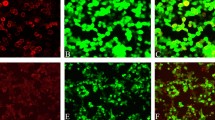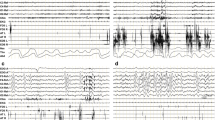Abstract
Purpose of review
This review aims to give an overview about the current knowledge of this novel neurological disorder associated to IgLON-5 antibodies and its treatment.
Recent findings
Anti-IgLON5 disease was first formally described in 2014. This newly discovered disorder recaps a complex neurological disorder with sleep, movement, and neuroimmunological and neurodegenerative aspects.
Summary
The clinical manifestation of the anti-IgLON5 disease is very heterogeneous mostly including a sleep disorder with non-rapid eye movement (REM) sleep parasomnia and REM behavior disorder besides obstructive sleep apnea syndrome and stridor. Other neurological features (bulbar symptoms, gait abnormalities, cognitive dysfunction) are common. Until today, the mean age of diagnosis was mostly above the age of 60 with a balanced distribution of sex. Neuropathological examination showed neuronal loss and gliosis associated with an atypical tauopathy mainly involving the tegmentum of brainstem and hypothalamus. Although the function of the antibodies stays unclear so far, the evidence for the pathogenetic role of the antibody becomes more evident. Among the association to HLA-DRB1*10:01 and HLA-DQB1*05:01 as a potential factor for susceptibility, immunopathological findings are promising. So far, the pathophysiology of anti-IgLON5 disease is not sufficiently enlightened and needs more interdisciplinary approach to a better understanding of this interesting disorder at the border of autoimmunity and neurodegeneration. Immunotherapy has been frequently used but its therapeutic effect is limited.



Similar content being viewed by others
References and Recommended Reading
Papers of particular interest, published recently, have been highlighted as: • Of importance •• Of major importance
•• Sabater L, Gaig C, Gelpi E, et al. A novel non-rapid-eye movement and rapid-eye-movement parasomnia with sleep breathing disorder associated with antibodies to IgLON5: a case series, characterisation of the antigen, and postmortem study. Lancet Neurol. 2014;13:575–86. This original research article describes the entity of IgLON-5 for the first time and its association to a new sleep disorder in eight patients.
Gelpi E, Höftberger R, Graus F, Ling H, Holton JL, Dawson T, et al. Neuropathological criteria of anti-IgLON5-related tauopathy. Acta Neuropathol. 2016;132:531–43.
•• Gaig C, Graus F, Compta Y, et al. Clinical manifestations of the anti-IgLON5 disease. Neurology. 2017;88:1736–43. This original research article describes the today known different types of the anti-IgLON5 disease in 22 patients.
Sabater L, Planaguma J, Dalmau J, Graus F. Cellular investigations with human antibodies associated with the anti-IgLON5 syndrome. J Neuroinflammation. 2016;13:226.
Escudero D, Guasp M, Ariño H, Gaig C, Martínez-Hernández E, Dalmau J, et al. Antibody-associated CNS syndromes without signs of inflammation in the elderly. Neurology. 2017;89:1471–5.
Bonello M, Jacob A, Ellul MA, Barker E, Parker R, Jefferson S, et al. IgLON5 disease responsive to immunotherapy. Neurol Neuroimmunol Neuroinflamm. 2017;4:e383.
Bruggemann N, Wandinger KP, Gaig C, et al. Dystonia, lower limb stiffness, and upward gaze palsy in a patient with IgLON5 antibodies. Mov Disord. 2016;31:762–4.
Haitao R, Yingmai Y, Yan H, Fei H, **a L, Honglin H, et al. Chorea and parkinsonism associated with autoantibodies to IgLON5 and responsive to immunotherapy. J Neuroimmunol. 2016;300:9–10.
Haitao R, Huiqin L, Tao Q, Xunzhe Y, **aoqiu S, Wei L, et al. Autoimmune encephalitis associated with vitiligo? J Neuroimmunol. 2017;310:14–6.
Högl B, Heidbreder A, Santamaria J, Graus F, Poewe W. IgLON5 autoimmunity and abnormal behaviours during sleep. Lancet. 2015;385:1590.
Simabukuro MM, Sabater L, Adoni T, Cury RG, Haddad MS, Moreira CH, et al. Sleep disorder, chorea, and dementia associated with IgLON5 antibodies. Neurol Neuroimmunol Neuroinflamm. 2015;2:e136.
Schroder JB, Melzer N, Ruck T, et al. Isolated dysphagiaas initial sign of anti-IgLON5 syndrome. Neurol Neuroimmunol Neuroinflamm. 2017;4:e302.
Honorat JA, Komorowski L, Josephs KA, Fechner K, St Louis EK, Hinson SR, et al. IgLON5antibody: neurological accompaniments and outcomes in20 patients. Neurol Neuroimmunol Neuroinflamm. 2017;4:e385.
Zhang W, Niu N, Cui R. Serial 18F-FDG PET/CT findings in a patient with IgLON5 encephalopathy. Clin Nucl Med. 2016;41:787–8.
Iranzo A. Parasomnias and sleep-related movement disorders in older adults. Sleep Med Clin. 2018;13(1):51–61.
Graus F, Santamaría J. Understanding anti-IgLON5 disease. Neurol Neuroimmunol Neuroinflamm. 2017;4:e393.
Wenninger S. Expanding the clinical spectrum of IgLON5-syndrome. J Neuromuscul Dis. 2017;4(4):337–9.
Mangesius S, Sprenger F, Höftberger R, Seppi K, Reindl M, Poewe W. IgLON5 autoimmunity tested negative in patients with progressive supranuclear palsy and corticobasal syndrome. Parkinsonism Relat Disord. 2017;38:102–3. https://doi.org/10.1016/j.parkreldis.2017.
Hasselbacher K, Steffen A, Wandinger KP, Brüggemann N. IgLON5 antibodies are infrequent in patients with isolated sleep apnea. Eur J Neurol. 2018 Apr;25:e46–7.
Mantere O, Saarela M, Kieseppä T, Raij T, Mäntylä T, Lindgren M, et al. Anti-neuronal anti-bodies in patients with early psychosis. Schizophr Res. 2018;192:404–7.
Nelson PT, Alafuzoff I, Bigio EH, Bouras C, Braak H, Cairns NJ, et al. Correlation of Alzheimer disease neuropathologic changes with cognitive status: a review of the literature. J Neuropathol Exp Neurol. 2012;71:362–81.
Dickson DW, Ahmed Z, Algom AA, Tsuboi Y, Josephs KA. Neuropathology of variants of progressive supranuclear palsy. Curr Opin Neurol. 2010;23:394–400.
Crary JF, Trojanowski JQ, Schneider JA, Abisambra JF, Abner EL, Alafuzoff I, et al. Primaryage-related tauopathy (PART): a common pathology associated with human aging. Acta Neuropathol. 2014;128:755–66.
Dickson DW, Hauw JJ, Agid Y, Litvan I. Progressive supranuclear palsy and corticobasal degeneration. In: Dickson DW, Weller RO, editors. Neurodegeneration: the molecular pathology of dementia and movement disorders, 2nd edn. Wiley-Blackwell. New York: Publishers; 2011. p. 135–55.
Kovacs GG. Neuropathology of tauopathies: principles and practice. Neuropathol Appl Neurobiol. 2015;41:3–23.
Cagnin A, Mariotto S, Fiorini M, Gaule M, Bonetto N, Tagliapietra M, et al. Microglial and neuronal TDP-43 pathology in anti-IgLON5-related tauopathy. J Alzheimers Dis. 2017;59:13–20.
• Dalmau J, Geis C, Graus F. Autoantibodies to synaptic receptors and neuronal cell surface proteins in autoimmune diseases of the central nervous system. Physiol Rev. 2017;97:839–87. This review article gives an excellent overview of the recently discovered and investigated pathophysiological pathways in antibody-mediated neurological disorders.
Karagogeos D. Neural GPI-anchored cell adhesion molecules. Front Biosci. 2003;8:s1304–20.
Hashimoto T, Yamada M, Maekawa S, Nakashima T, Miyata S. IgLON cell adhesion molecule Kilon is a crucial modulator for synapse number in hippocampal neurons. Brain Res. 2008;1224:1–11.
Sanz R, Ferraro GB, Fournier AE. IgLON cell adhesion molecules are shed from the cell surface of cortical neurons to promote neuronal growth. J Biol Chem. 2015;290(7):4330–42.
Minhas HM, Pescosolido MF, Schwede M, Piasecka J, Gaitanis J, Tantravahi U, et al. An unbalanced translocation involving loss of 10q26.2 and gain of 11q25 in a pedigree with autism spectrum disorder and cerebellar juvenile pilocytic astrocytoma. Am J Med Genet A. 2013;161:787–91.
Sellar GC, Watt KP, Rabiasz GJ, Stronach EA, Li L, Miller EP, et al. OPCML at 11q25 is epigenetically inactivated and has tumor-suppressor function in epithelial ovarian cancer. Nat Genet. 2003;34:337–43.
Huijbers MG, Querol LA, Niks EH, Plomp JJ, van der Maarel SM, Graus F, et al. The expanding field of IgG4-mediated neurological autoimmune disorders. Eur J Neurol. 2015;22:1151–61.
Ohta K, Shigemoto K, Fu**ami A, Maruyama N, Konishi T, Ohta M. Clinical and experimental features of MuSK antibody positive MG in Japan. Eur J Neurol. 2007;14:1029–34.
Moscato EH, Peng X, Jain A, Parsons TD, Dalmau J, Balice-Gordon RJ. Acute mechanisms underlying antibody effects in anti-N-methyl-D-aspartate receptor encephalitis. Ann Neurol. 2014;76:108–19.
Hashimoto T, Maekawa S, Miyata S. IgLON cell adhesion molecules regulate synaptogenesis in hippocampal neurons. Cell Biochem Funct. 2009;27:496–8.
Author information
Authors and Affiliations
Corresponding author
Ethics declarations
Conflict of Interest
Anna Heidbreder reports honoraria received from Servier, UCB, Bioprojet, Medice, and Fortbildungs Kolleg.
Konstanze Philipp declares no potential conflicts of interest.
Human and Animal Rights and Informed Consent
This article does not contain any studies with human or animal subjects performed by any of the authors.
Additional information
This article is part of the Topical Collection on Sleep Disorders
Rights and permissions
About this article
Cite this article
Heidbreder, A., Philipp, K. Anti-IgLON 5 Disease. Curr Treat Options Neurol 20, 29 (2018). https://doi.org/10.1007/s11940-018-0515-4
Published:
DOI: https://doi.org/10.1007/s11940-018-0515-4




